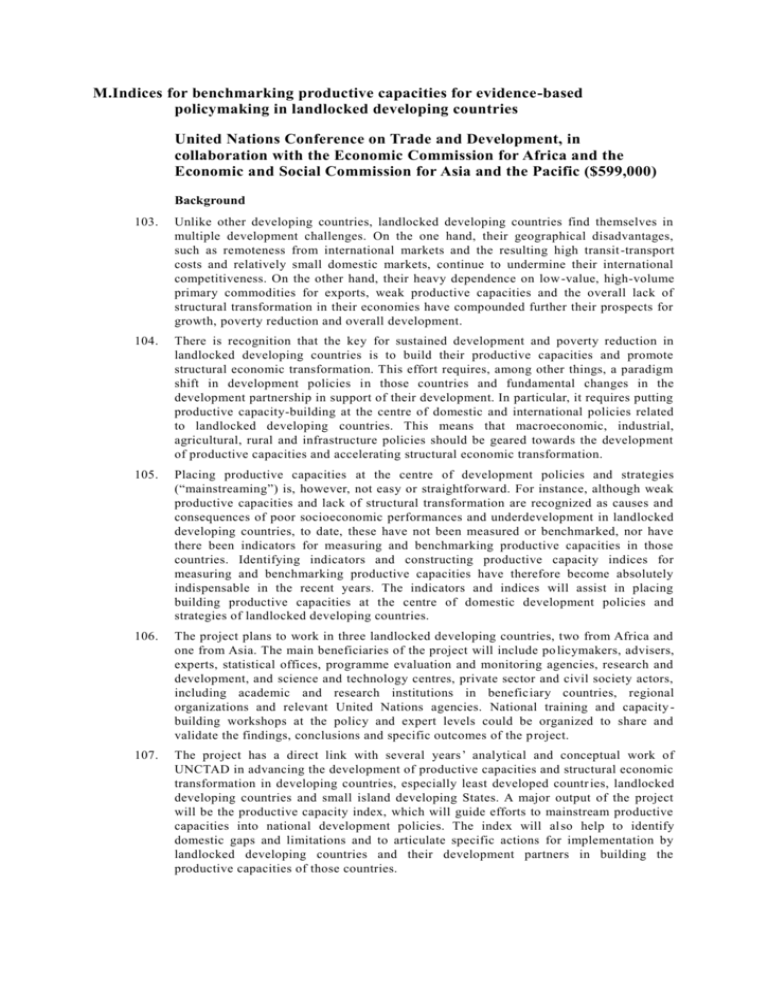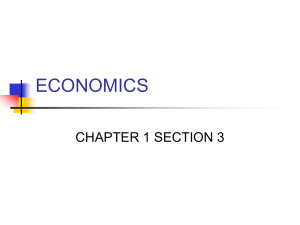M. Indices for benchmarking productive capacities for evidence
advertisement

M.Indices for benchmarking productive capacities for evidence-based policymaking in landlocked developing countries United Nations Conference on Trade and Development, in collaboration with the Economic Commission for Africa and the Economic and Social Commission for Asia and the Pacific ($599,000) Background 103. Unlike other developing countries, landlocked developing countries find themselves in multiple development challenges. On the one hand, their geographical disadvantages, such as remoteness from international markets and the resulting high transit -transport costs and relatively small domestic markets, continue to undermine their international competitiveness. On the other hand, their heavy dependence on low -value, high-volume primary commodities for exports, weak productive capacities and the overall lack of structural transformation in their economies have compounded further their prospects for growth, poverty reduction and overall development. 104. There is recognition that the key for sustained development and poverty reduction in landlocked developing countries is to build their productive capacities and promote structural economic transformation. This effort requires, among other things, a paradigm shift in development policies in those countries and fundamental changes in the development partnership in support of their development. In particular, it requires putting productive capacity-building at the centre of domestic and international policies related to landlocked developing countries. This means that macroeconomic, industrial, agricultural, rural and infrastructure policies should be geared towards the development of productive capacities and accelerating structural economic transformation. 105. Placing productive capacities at the centre of development policies and strategies (“mainstreaming”) is, however, not easy or straightforward. For instance, although weak productive capacities and lack of structural transformation are recognized as causes and consequences of poor socioeconomic performances and underdevelopment in landlocked developing countries, to date, these have not been measured or benchmarked, nor have there been indicators for measuring and benchmarking productive capacities in those countries. Identifying indicators and constructing productive capacity indices for measuring and benchmarking productive capacities have therefore become absolutely indispensable in the recent years. The indicators and indices will assist in placing building productive capacities at the centre of domestic development policies and strategies of landlocked developing countries. 106. The project plans to work in three landlocked developing countries, two from Africa and one from Asia. The main beneficiaries of the project will include po licymakers, advisers, experts, statistical offices, programme evaluation and monitoring agencies, research and development, and science and technology centres, private sector and civil society actors, including academic and research institutions in beneficiary countries, regional organizations and relevant United Nations agencies. National training and capacity building workshops at the policy and expert levels could be organized to share and validate the findings, conclusions and specific outcomes of the p roject. 107. The project has a direct link with several years’ analytical and conceptual work of UNCTAD in advancing the development of productive capacities and structural economic transformation in developing countries, especially least developed countr ies, landlocked developing countries and small island developing States. A major output of the project will be the productive capacity index, which will guide efforts to mainstream productive capacities into national development policies. The index will al so help to identify domestic gaps and limitations and to articulate specific actions for implementation by landlocked developing countries and their development partners in building the productive capacities of those countries. Objective of the Organization: To strengthen the capacity of selected landlocked developing countries to develop productive capacity indices and use them to support evidence-based policymaking Relationship to the biennial programme plan for the period 2016-2017: Trade and development subprogramme 5 (Africa, least developed countries and special programmes); Economic and social development in Asia and the Pacific subprogramme 1 (Macroeconomic policy and inclusive development); Economic and social development in Africa subprogramme 1 (Macroeconomic policy) Summary budget (Thousands of United States dollars) General temporary assistance Consultants Travel Operating expenses Workshops/training Total Expected accomplishments of the Secretariat Indicators of achievement (EA1) Increased capacity of relevant ministries and entities to measure and benchmark productive capacities with the help of productive capacity indices (IA1.1) Productive capacity indices constructed and validated in the three targeted countries (EA2) Increased capacity of policymakers in beneficiary countries to understand, interpret and use productive capacity indices as a tool to formulate and monitor policies and strategies aimed at enhancing productive capacity and structural transformation (IA2.1) 75 per cent of trained policymakers in the three targeted countries confirm increased capacity to use productive capacity indices in formulating evidence-based policies and strategies and monitoring their progress (EA3) Improved capacity of selected countries to regularly collect statistics and related information in key areas of productive capacities (IA3.1) Institutions dealing with statistics in the three project countries confirm improved capacity to collect statistics and related information in key areas of productive capacities (IA2.2) Policymakers in all three targeted countries have taken steps to improve policies and strategies aimed at enhancing productive capacity and structural transformation based on productive capacity indices Main activities 108. 60.0 126.0 150.0 8.0 255.0 599.0 The main activities of the project will include: (A1.1) Defining the conceptual, methodological and statistical framework for identifying, selecting and validating indicators that will be used in the construction of productive capacity indices; (A1.2) Systematically collecting and organizing statistical data and related information on key issues and developing productive capacity indices on the basis of available data and statistical information; (A1.3) Undertaking national case studies in selected landlocked developing countries to assess the state or conditions of policy and institutional framework for building productive capacities in the selected countries, the synthesis of which will be included in a publication; (A1.4) Validating indicators identified and productive capacity indices constructed by undertaking consultations, through advisory missions, with key ministries and relevant entities in beneficiary countries. This activity is intended to identify crucial ministries as “champions” of the work undertaken and the findings and conclusions of the project, which is the key to ensuring ownership and mobilizing wider stakeholders as to the benefit of the exercise; (A2.1) Organizing national training workshops at the expert level on the conceptual, methodological and statistical issues, and on the construction and interpretation of productive capacity indices. The workshops enable participants to clearly understand conceptual, methodological and statistical issues behind productive capacity indices; (A2.2) Organizing national training workshops at the policy level on the interpretation, validation and use of productive capacity indices in the formulation of domestic development policies and strategies, and monitoring their implementation; (A2.3) Establishing national advisory services with the aim of reorienting policies and strategies towards building productive capacities; (A3.1) Developing a portal for online publication of the productive capacity indices together with key indicators used in the construction of the indices. The portal will be useful to continuously update the indices and share experiences and best practices throughout countries and regions in building productive capacities. In an effort to disseminate the productive capacity indices, the portal will be launched and the information will be made available at national workshops and various meetings outside this project; (A3.2) As part of national statistical capacity-building, organizing workshops for intensive “training of trainers” in updating and maintaining productive capacity indices. The trained trainers will subsequently train technocrats from selected ministries and institutions. M: Indices for benchmarking productive capacities for evidence based policymaking in landlocked developing countries Implementing entities: UNCTAD in collaboration with ECA and ESCAP Duration: 2016 – 2019 Objective: To strengthen the capacity of selected landlocked developing countries to develop Productive Capacity Indices (PCIs) and use them to support evidence based policy making Summary budget Detailed budget (US dollars) (Thousands of United States dollars) General temporary assistance Consultants Travel Operating Expenses 60.0 126.0 150.0 8.0 Workshops/training Total 255.0 599.0 General Temporary Assistance Temporary statistical assistance is required for collecting basic data and information to help identify key indicators as basis for constructing Productive Capacity Index in support of activities A1.2, A3.1 and A3.2, 5 WM x $6,000 per month = $30,000 General temporary assistance is required to assist in organizing national workshops and to provide secretarial and clerical support for the project (A1.3, A2.1, A.2.2, A3.1 and A3.2) (5 WM x $6,000 per month = $30,000) Consultants International consultants One international consultant will be required for the preparation of conceptual, methodological and statistical framework for identifying, selecting and validating indicators for constructing Productive Capacity Indices. S/he will also participate in the national workshops to assist in the use and interpretation of PCI (Activity A1.1, A1.2, A2.1 and A2.2) (3 WM x $ 10,000 per month) + 3 travels to national workshops (3 x $5,000) = $ 45,000) One additional IT Specialist for designing portal for web publishing (including the design of brochures and flyers on the key findings and recommendations of the project) in support A3.1 [3 WM] x $10,000 = $30,000 National Consultant Three national consultants, one for each target country will be selected, who will be required for the preparation of national case studies (A1.3) to assess the state or conditions of policy and institutional framework for building productive capacities in their respective countries (2 [WM] x 3 national consultants x $6,000 per month = $36,000 ) Evaluation consultants External evaluation: International consultant to cover 1 WM ($10,000) plus travel and DSA to one national training workshop (1 x $5,000) = $15,000 Travel of Staff 60 000 126 000 150 000 30 Three national training workshops in support of A2.1, A2.2 and A3.2 in the three target LLDCs each for two days: Travel +DSA for two staff ($5,000 per mission x 2 staff x 3 workshops) = $30,000 Three advisory missions aimed at reorienting policies and strategies in three target countries in support of A2.3 (each for two days): Travel + DSA for 4 staff from key participating agencies for a total duration of 6 days (two days per country) ( travel + DSA = $5,000 per mission x 4 staff x 3 target countries = $ 60,000) Technical consultations for validation of PCIs in three target countries in support of A1.4: for three days each involving 4 staff from implementing agencies (3 x 4 x $5,000 (travel + DSA) = $60,000). In the case of African countries 2 staff from UNCTAD, 1 staff from UN-OHRLLS and 1 from UN-ECA. For Asian Countries, 2 from UNCTAD, 1 From OHRLLS and 1 from UN-ESCAP Operating Expenses Operating expenses $8,000 (for editing, translating into French and formatting an online publication) Seminars, Workshops and Study Tours Three national expert level training workshops in support of A2.1 for an in-depth and technical discussions on underlying concepts, rationale and methodology; sources of data and techniques of measurement (benchmark) and interpretation and use of indicators and Productive Capacity Indices (with 50 experts outside of government institutions such as academia and the private sector in each target country for three days (3 x $ 30,000 per country) = $90,000. This sum is required for securing conference facilities, languages interpreters, resource persons (facilitators) as well as conference logistic. Three National policy-level training workshops on interpretation, validation and use of indicators and Productive Capacity Indices as a policy tool for senior officials and policy makers drawn from various relevant institutions (50 participants for two days) in support of activity A2.2. The budget will be used for securing conference facilities, languages interpreters, resource persons (facilitators) as well as conference logistics (3 x $30,000) = $90,000 Three workshops for intensive "Training of Trainers" in updating and maintaining PCIs as part of the national statistical capacity building training workshops in support of A3.2 (3 x $25,000 per country= $75,000). This involves the training of core group of statisticians and specialists on conceptual framework, data sources, methodology and techniques used in measuring or benchmarking productive capacities and developing PCIs 8 000 255 000 31 32







